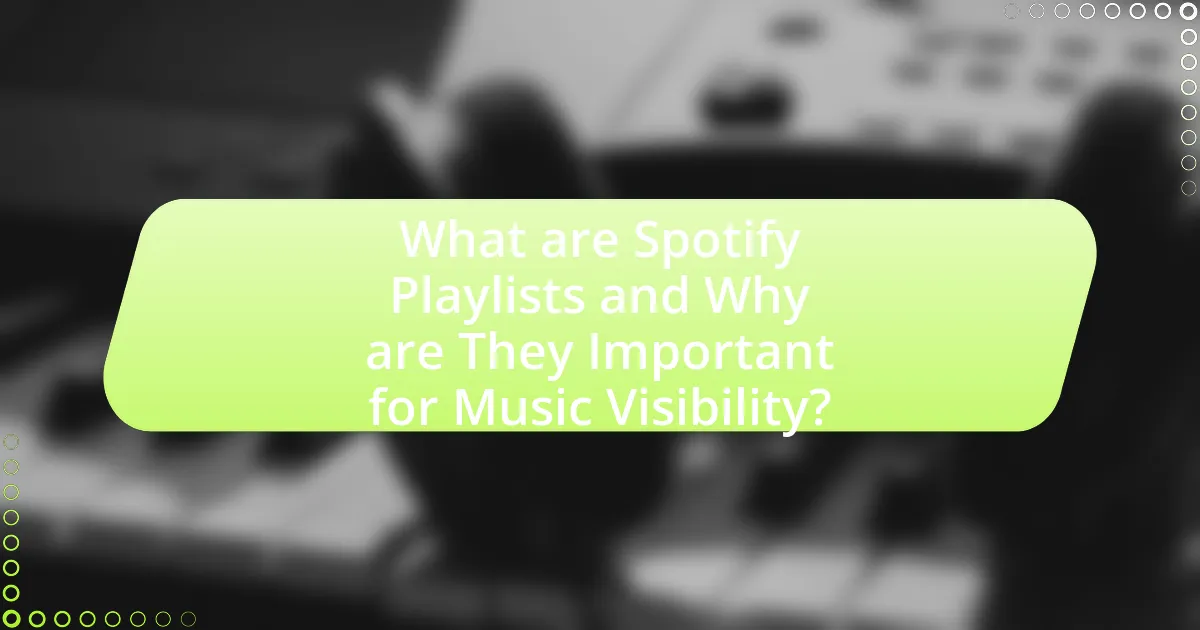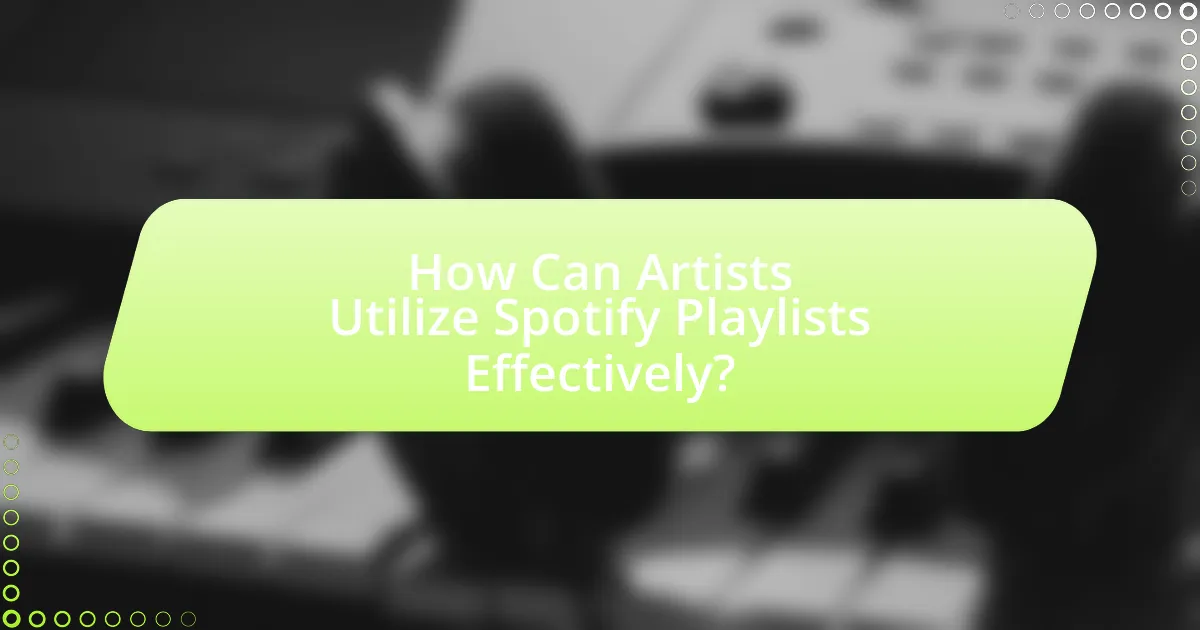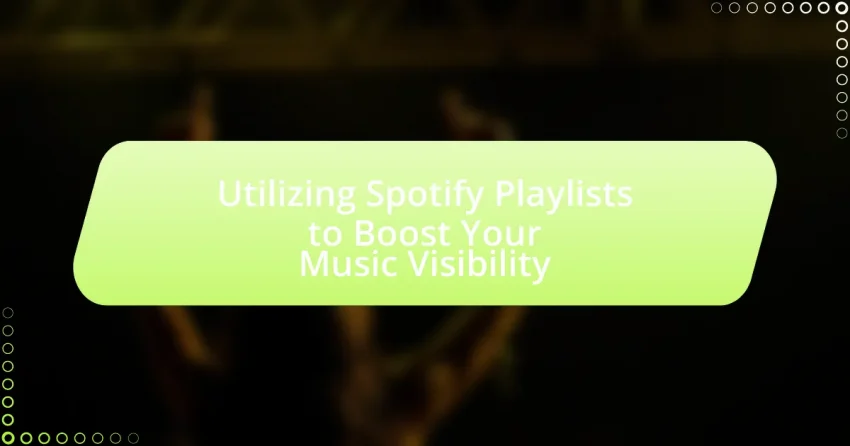Spotify playlists are curated collections of songs that play a crucial role in enhancing music visibility and discovery on the platform. With over 60% of users preferring playlists over individual tracks, being featured on popular playlists can significantly boost an artist’s streaming numbers and overall recognition. The article explores the various types of playlists available on Spotify, the influence of the platform’s algorithm on playlist placements, and effective strategies for artists to utilize playlists to promote their music. Additionally, it addresses the importance of networking with playlist curators, best practices for submitting music, and metrics to track for measuring the impact of playlist placements.

What are Spotify Playlists and Why are They Important for Music Visibility?
Spotify playlists are curated collections of songs that users can listen to on the Spotify platform. These playlists are important for music visibility because they significantly increase the chances of songs being discovered by new listeners. According to Spotify, over 60% of users listen to playlists rather than individual tracks, highlighting the playlists’ role in music consumption. Additionally, being featured on popular playlists can lead to substantial increases in streaming numbers, as tracks included in playlists often receive more exposure than those that are not. This exposure can result in higher chart placements and greater overall artist recognition.
How do Spotify Playlists function in the music ecosystem?
Spotify playlists serve as curated collections of songs that enhance music discovery and visibility within the music ecosystem. These playlists, which can be algorithmically generated or manually curated by Spotify editors, play a crucial role in promoting artists and tracks to a wider audience. For instance, playlists like “Today’s Top Hits” or “RapCaviar” have millions of followers, significantly impacting streaming numbers and chart performance for featured artists. Data shows that tracks included in popular playlists can experience a substantial increase in streams, often leading to higher placement on music charts and increased fan engagement.
What types of playlists exist on Spotify?
Spotify features several types of playlists, including curated playlists, algorithmic playlists, user-generated playlists, and editorial playlists. Curated playlists are created by Spotify’s editorial team or music experts, showcasing specific genres or themes. Algorithmic playlists, such as Discover Weekly and Release Radar, are generated based on user listening habits and preferences. User-generated playlists are created by Spotify users, allowing them to share their favorite tracks with others. Editorial playlists are also curated by Spotify but often focus on specific moods, activities, or events, providing listeners with tailored music experiences. These diverse playlist types enhance music visibility and engagement on the platform.
How does Spotify’s algorithm influence playlist placements?
Spotify’s algorithm influences playlist placements by analyzing user behavior, song performance metrics, and contextual data to determine which tracks are most likely to engage listeners. The algorithm considers factors such as streaming history, user preferences, and the popularity of songs to curate personalized playlists. For instance, Spotify uses machine learning models that evaluate millions of data points, including skip rates and saves, to optimize song recommendations. This data-driven approach ensures that tracks with higher engagement potential are prioritized in playlists, thereby enhancing visibility for artists whose music aligns with listener trends.
What role do playlists play in promoting music?
Playlists play a crucial role in promoting music by increasing exposure and accessibility for artists. They aggregate songs into curated collections, making it easier for listeners to discover new music. For instance, Spotify’s algorithmic and editorial playlists can significantly boost an artist’s streams; tracks featured on popular playlists can experience a surge in plays, sometimes increasing by hundreds of thousands. According to a study by the Music Business Association, over 60% of listeners discover new music through playlists, highlighting their effectiveness in reaching wider audiences.
How can playlists increase listener engagement?
Playlists can increase listener engagement by providing curated content that aligns with listeners’ preferences and moods. This targeted approach enhances the listening experience, as users are more likely to discover and enjoy music that resonates with them. According to a study by Spotify, playlists account for over 30% of all streams on the platform, indicating their significant role in listener behavior. Additionally, playlists encourage repeated listens and longer listening sessions, as users often return to their favorite curated collections, further boosting engagement metrics.
Why are curated playlists significant for emerging artists?
Curated playlists are significant for emerging artists because they provide essential exposure to new audiences. These playlists often have established followings, allowing artists to reach listeners who may not discover their music otherwise. For instance, Spotify’s editorial playlists can significantly increase streaming numbers; tracks featured on popular playlists can see a surge in plays, sometimes by thousands or even millions. This exposure can lead to increased fan engagement, social media following, and opportunities for live performances. Additionally, being included in curated playlists can enhance an artist’s credibility and visibility in a competitive music landscape, making it a crucial strategy for emerging talent.

How Can Artists Utilize Spotify Playlists Effectively?
Artists can utilize Spotify playlists effectively by strategically submitting their music to curated playlists and engaging with their audience through playlist promotion. By targeting playlists that align with their genre and style, artists increase their chances of being featured, which can lead to significant exposure; for instance, tracks featured on popular playlists can receive thousands to millions of streams, enhancing visibility and listener engagement. Additionally, artists can create their own playlists that include their music alongside similar artists, fostering a community and encouraging listeners to explore their catalog. This approach not only promotes their music but also builds a loyal fan base, as listeners appreciate curated content that resonates with their tastes.
What strategies can artists employ to get featured on playlists?
Artists can employ several strategies to get featured on playlists, including building relationships with playlist curators, optimizing their music metadata, and promoting their tracks on social media. Establishing connections with curators can lead to direct submissions and increased chances of being featured, as many curators prefer artists they know or have engaged with. Additionally, ensuring that music metadata is accurate and complete helps curators easily find and categorize tracks, which is crucial for playlist consideration. Promoting music on social media platforms can also generate buzz and attract the attention of curators, as playlists often reflect trending songs and popular artists. According to a study by Spotify, tracks that gain traction on social media are more likely to be added to playlists, demonstrating the importance of an artist’s online presence.
How important is networking with playlist curators?
Networking with playlist curators is crucial for artists seeking to enhance their music visibility on platforms like Spotify. Curators have the power to significantly increase an artist’s reach by including their tracks in popular playlists, which can lead to higher streaming numbers and greater audience engagement. According to a study by Spotify, tracks featured on curated playlists can experience up to a 200% increase in streams compared to those that are not. This demonstrates the direct impact that effective networking with curators can have on an artist’s success in the competitive music landscape.
What are the best practices for submitting music to playlists?
The best practices for submitting music to playlists include researching the playlist’s genre and audience, personalizing your submission message, and ensuring high-quality audio. Researching helps identify playlists that align with your music style, increasing the chances of acceptance. Personalizing your submission message demonstrates genuine interest and can make your submission stand out. High-quality audio is essential, as curators prefer professionally produced tracks that reflect well on their playlists. These practices enhance the likelihood of your music being featured, as evidenced by successful artists who have utilized similar strategies to gain visibility on platforms like Spotify.
How can artists create their own playlists to boost visibility?
Artists can create their own playlists to boost visibility by curating a selection of their music alongside tracks from other artists that complement their style. This strategy not only showcases their work but also engages listeners who enjoy similar genres, increasing the likelihood of being discovered. By sharing these playlists on social media and collaborating with other artists for cross-promotion, they can reach wider audiences. Additionally, artists can utilize Spotify’s algorithm by regularly updating their playlists, which can enhance their chances of being featured in Spotify’s algorithmic playlists, further amplifying their visibility.
What should be considered when curating a personal playlist?
When curating a personal playlist, one should consider the target audience and the emotional journey the playlist aims to create. Understanding the preferences and listening habits of the intended audience helps in selecting tracks that resonate with them. Additionally, the flow and pacing of the playlist are crucial; transitions between songs should maintain listener engagement and evoke the desired emotions. Research indicates that playlists with a coherent theme or mood can enhance listener satisfaction, as evidenced by Spotify’s algorithm favoring playlists that keep users engaged for longer periods.
How can artists promote their playlists to reach a wider audience?
Artists can promote their playlists to reach a wider audience by leveraging social media platforms, collaborating with other artists, and utilizing playlist submission services. Social media platforms like Instagram, Twitter, and TikTok allow artists to share their playlists directly with followers, increasing visibility. Collaborating with other artists can introduce their playlists to new listeners, as fans of the collaborator may explore the artist’s music. Additionally, using playlist submission services can help artists get their playlists featured on popular playlists, which can significantly boost audience reach. According to a study by Spotify, playlists are a primary way listeners discover new music, highlighting the importance of effective promotion strategies.

What Metrics Should Artists Track to Measure Playlist Impact?
Artists should track metrics such as streams, saves, playlist adds, and follower growth to measure playlist impact. Streams indicate how many times a song has been played, reflecting listener engagement. Saves show how many users have added the song to their library, indicating its appeal. Playlist adds reveal how often the song is included in user-generated or curated playlists, which can enhance visibility. Follower growth on platforms like Spotify can also indicate the effectiveness of playlist placements in attracting new listeners. According to Spotify’s data, songs featured on popular playlists can experience a significant increase in streams, often leading to a 30% or more rise in listener engagement within the first week of being added.
How can artists analyze the performance of their music on playlists?
Artists can analyze the performance of their music on playlists by utilizing analytics tools provided by streaming platforms like Spotify for Artists. These tools offer insights into key metrics such as the number of streams, listener demographics, and playlist placements, allowing artists to assess how their tracks are performing in various playlists. For instance, Spotify for Artists provides data on how many listeners discovered a song through playlists, which can help artists understand the impact of playlist placements on their overall reach and engagement. Additionally, tracking changes in follower counts and streaming trends over time can further inform artists about the effectiveness of their music on playlists.
What tools are available for tracking Spotify playlist metrics?
Several tools are available for tracking Spotify playlist metrics, including SpotOnTrack, Chartmetric, and Soundcharts. SpotOnTrack allows users to monitor playlist placements and track changes in real-time, providing insights into how songs perform across various playlists. Chartmetric offers comprehensive analytics, including follower counts, playlist performance, and engagement metrics, which help artists and labels make data-driven decisions. Soundcharts provides similar features, focusing on real-time data and analytics for playlists, social media, and radio airplay, enabling users to assess their music’s reach and impact effectively. These tools are widely recognized in the music industry for their ability to deliver actionable insights into playlist performance.
How do streaming numbers correlate with playlist placements?
Streaming numbers directly influence playlist placements, as higher streaming counts often lead to increased visibility and inclusion in popular playlists. Platforms like Spotify utilize algorithms that prioritize tracks with significant streaming activity, indicating listener engagement and popularity. For instance, a study by the University of Southern California found that songs featured on Spotify’s editorial playlists experienced a 30% increase in streams within the first week of placement, demonstrating a clear correlation between streaming performance and playlist visibility.
What are common challenges artists face with Spotify playlists?
Artists commonly face challenges such as playlist placement, algorithmic visibility, and competition for attention on Spotify. Securing a spot on popular playlists is difficult due to the high volume of submissions and the selective nature of curators, which can limit exposure for emerging artists. Additionally, Spotify’s algorithm favors tracks with higher engagement metrics, making it challenging for lesser-known artists to gain traction. The intense competition among numerous artists vying for limited playlist slots further complicates the landscape, often resulting in frustration and decreased visibility for many.
How can artists overcome rejection from playlist submissions?
Artists can overcome rejection from playlist submissions by analyzing feedback, refining their music, and targeting appropriate playlists. When artists receive rejection, they should seek constructive criticism, which can provide insights into why their music did not fit the playlist’s theme or style. This feedback allows artists to make necessary adjustments to their tracks, such as improving production quality or enhancing lyrical content. Additionally, artists should research and identify playlists that align closely with their genre and sound, increasing the likelihood of acceptance. According to a study by Spotify, playlists with a specific niche audience tend to have higher engagement rates, indicating that targeting the right playlists can significantly improve submission success.
What strategies can help maintain visibility after initial playlist success?
To maintain visibility after initial playlist success, artists should engage with their audience through consistent social media updates and live performances. Engaging with fans fosters loyalty and encourages sharing, which can amplify visibility. Additionally, artists should seek to get featured on more playlists by reaching out to curators and utilizing platforms that connect musicians with playlist opportunities. According to a study by Spotify, tracks that remain active on playlists for longer periods see a 30% increase in streams, highlighting the importance of ongoing playlist placements. Regularly releasing new music and collaborating with other artists can also keep the momentum going, as fresh content attracts both new listeners and retains existing fans.
What are the best practices for maximizing music visibility through playlists?
To maximize music visibility through playlists, artists should focus on targeting the right playlists, engaging with curators, and promoting their music effectively. Targeting playlists that align with the genre and style of the music increases the chances of being featured, as playlists often cater to specific audiences. Engaging with curators by building relationships and understanding their preferences can lead to more opportunities for inclusion. Additionally, promoting the playlist through social media and other channels can drive more listeners to the music, enhancing visibility. According to a study by Spotify, tracks featured on popular playlists can experience a significant increase in streams, demonstrating the effectiveness of these practices.
